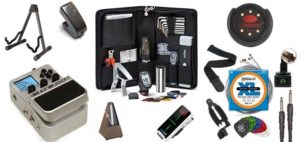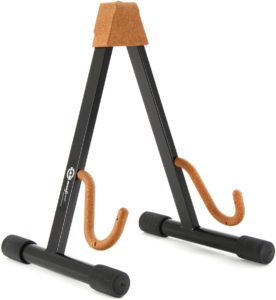The Advice for Beginner Guitar Players Guide provides the new guitar owner with answers to many questions new learners have. After years of teaching thousands of students, I have had the opportunity to answer many genuine questions and concerns that my students have. There is never a one size fits all answer at Miami Guitar Workshop. That is why I created “The Beginning Guitar Learner’s Guide.” The Advice for Beginner Guitar Players Guide are works in progress, as there are always new questions popping up. Just as my students learn from me, I am always learning from them!
___
It really doesn’t take that long to learn to play!
You are about to learn the answer to the most common question people learning to play the guitar have. The most common question I get as a teacher is, “How long will it take before I can play a song?” The great news is that it really does not take that long to play a song on the guitar! And, there is more good news….
This seems obvious, and that’s why “The Beginner Guitar Guide” is here for you! The guitar has already been “figured out!” In other words, there are so many people who play! So, why not you? Playing the guitar is not an unsolved mystery. Learning a song on the guitar simply requires developing your muscle memory, incorporating little bit of rhythm, and simply knowing how the song goes. From there, all you have to do is play the song every day, SLOWLY and CAREFULLY!
Most people want to rush straight into playing a song at its original tempo and that where the frustration occurs. All you need to do is be a little. If you do that, I guarantee that you can play a song in a short amount of time. Finally, it’s very important that you attend lessons regularly. By doing so you will cut months and sometimes years off of the amount time it takes you to become good. Below is a chart showing the progress over a 5-week period of a student who studies at the Miami Guitar Workshop versus other ways of learning. Book your 5-week supercharged course now and Call 305.274.8465 and put The Beginning Guitar Learner’s Guide into action!
Play what feels best and inspires you!
The kind of guitar that you decide to play varies greatly from one student to the next. An acoustic steel string guitar might suit you best if you love folk and country music, whereas if you are into electric blues, a Tele, Strat, or any number of guitars will help you get the sound that you are looking for. The type of guitar you play has quite a bit to do with being inspired. How a guitar feels is equally as important. A staple rule in The Beginner Guitar Guide is a guitar that feels “right,” is a guitar that is set up so that you can play it with ease. If you have to physically fight the guitar while learning a song or a riff, the fun-factor starts to vanish. Beginners and advanced players alike get easily discouraged when they are struggling with a poorly set up guitar. Choose a guitar whose shape fits your tastes and comfort while taking into consideration what styles of music you really enjoy. Playing music is fun and we do not want anything to get in the way of letting our creativity shine. At the Miami Guitar Workshop, I am able to do set-ups for students which is handy for those who cannot find the time to go to a guitar tech.
Yes, you should!
After you have mulled over the idea of buying a guitar for weeks, you finally go to the store and choose a guitar that you like. The salesman brings you to the counter to pay. Just when you think you are done, the salesman goes hyper-drive trying to sell you accessories! Here is a list of some are some of accessories:
•string winder
•tuner
•guitar stand
•guitar polish
•guitar polish cloth
•guitar strap
•foot stool
•beginner’s book
•extra pack of strings
•Fog machine
All joking and fog machines aside, the answer is “yes!” There are accessories that you should absolutely buy. You will use every one of the items in the list over and over again.
LUckily, you have read “The Beginner Guitar Guide!” Being new to the world of guitar and music stores can be very confusing. It is also possible to be misled by salespeople trying to make a few dollars. The Miami Guitar Workshop can help you purchase an instrument that you will love while also directing you on exactly what to purchase so you do not overspend. If you have already purchased a guitar, but have no idea what sort of accessories to buy, I can help. Why? Because I have made all the mistakes (and then some) over 40 years of playing the guitar, which is why I have created this Guitar Learner’s Guide. I want to steer you away from the common pitfalls new guitar owners veer off into and save you money and time. Contact the Miami Guitar Workshop @ 305-274-8465 and I will help you get everything that you need to begin your musical journey!
Creativity flows best when you can move with ease!
How high should I wear my guitar? Straps can come in a variety of styles and yet there are only 2 variables that are really important to the user. Is the strap adjustable and is it comfortable? Answering these few questions will help you make the best choice on what sort of strap you should buy. How heavy is the guitar? The weight of the guitar plays a significant role in how comfortable the strap will be. A heavy Les Paul style guitar with a very thin strap with become very uncomfortable within minutes of playing. So, if you like the look of thinner straps, Great! Generally speaking, you will find you comfort level increases as the weight of the instrument decreases. Also, Skill level seems to be directly related to how high the guitar is worn. Playing highly technical solos and complex chords are played on a guitar that is worn medium to high. This is simply because the hand is in more of a neutral position as the guitar is positioned higher and it is simply more easier to move.
Obviously, it is impossible to expect broad generalizations to be true for everyone, as there will always be the exception to the rule. Finally and this is sort of funny, you will notice (on the graph) that the “Cool Factor” goes downward as the guitar goes up past the hip. Lots of people do not care about the “loss of cool,” while others consider it a personal crisis! I always recommend to do what feels the most comfortable and allows you the ease of playing.
Longer is not better!
All too often a guitar student will arrive with a 25ft long cable. This is no accident. It is obvious that the guitar salesperson was simply trying to make a little more of a commission buy selling a longer cable, which is usually marketed as a high-quality cable. “High quality” means it is more expensive, which again leaves you with less money in your wallet. When buying an electric guitar cable for the first time or 10th time for that matter, everyone asks themselves, “how long of a guitar cable should I buy?!”
There are many reasons to not buy a long guitar cable, which by the way is also called a “patch cord,” or “patch cable”).
• Long cables tangle themselves into a spaghetti mess. Sort of like this…
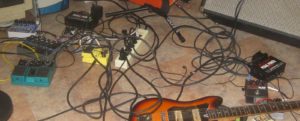
• Long cables are more likely to get walked on, rolled over and jammed into cases recklessly, Therefore, the break more often. That more $ out of your pocket…again!
• The longer the cable, the more the quality of the guitar signal degrades
I would suggest anywhere from an 8-10ft cable to start with. If you would like to share your experiences in the Beginner Guitar Guide, simply drop me a line!
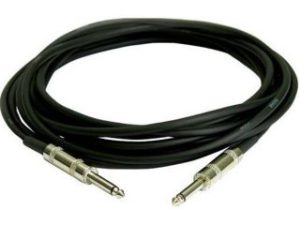
You need it!
There is no doubt that we are in the golden age of tuners. If you are asking yourself, “Do I need a tuner?” The answer is unequivocally, “YES!”
Tuners are great, fun, handy, easy-to-use and guess what? After using one correctly, your guitar is in tune! I know that makes simple sense. At this point in time, there is no reason whatsoever to be playing out of tune. There are so many cool tuners available at our fingertips that it is nearly overwhelming.
There are clip on tuners, tuners you plug into, guitar tuning apps, FREE guitar tuning apps, tuners that tune all 6 strings simultaneously, fancy looking tuners, old-school looking tuners, etc. Aside from taking all shapes and sizes, there are tuners that fit certain applications better than others. There is clearly a difference in quality amongst guitar tuners. Some are more accurate than others. At the Miami Guitar Workshop, we can quickly assess what your needs are and guide you to making a purchase that will provide you the most value.
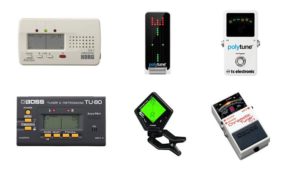
The heavier it is the harder it is.
Inevitably, you will need to change your strings. When you go to the music shop the salesperson will ask you, “What gauge strings would you like?” If you are new to the guitar you may simply not know how to answer that question. Thanks to “Beginner Guitar Guide,” you know exactly how to handle this situation!
The gauge of the string directly relates to how thick they are. Electric guitar strings are generally sold based on the gauge number of the thinnest/highest sounding string. For example, if the top string is 10-gauge string, you could simply ask for “a pack of 10s.” The salesperson will understand the request easily.
Acoustic guitar string gauges are many times classified by “Extra Light,” “Light,” and “Medium.” If you know the gauge of the highest/thinnest string (as with electric stings) you could just as easily tell the salesperson that gauge and he could try to find a set that fit your needs, but rest assured that unless he is an authority on strings he is more used to the hearing “Medium” etc.
If you play a classical style guitar, you will need nylon strings. Nylon string tensions range from “Light Tension” to “Extra Hard tension.” They also use gauge numbers. However, like acoustic strings you would most often use the name as opposed to the gauge.
Heavier, or higher-gauged strings are more challenging to play. The positive side is that there tends to be more tone and volume that comes from a heavier string. Although this is a fact, it does not suit all styles of music well. For example, heavy gauge strings are not used in Metal.
There are many components that factor in to choosing which gauge suits you the best. At the Miami Guitar Workshop, we have the experience to direct you to which brand and which gauge guitar strings would suit you the best!
Not at the beginning.
Pictures and videos of guitars are everywhere. In magazines, in online catalogues, and even on some bus benches we see pictures of guitar players shredding away. Many of those times you can see the guitar player has boxes at their feet that they can step on. These are called effects pedals, or better “stomp boxes.” The first thing new learners ask is, “Do I need to get one of those pedals?”
This is a legitimate question, too. You first pick up the guitar so you can make sounds like the players you like. Even though you do not need an effects pedal when you start learning, it is lots of fun to go online and search to hear and see what the pedals do to the sound.
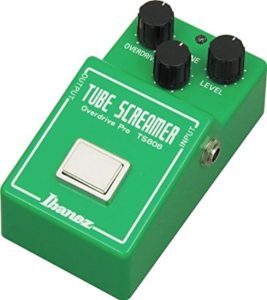
Good sounding effects pedals can range from pricey to very pricey. I always recommend my students spend wisely and spend once. In other words, why by a cheapo pedal that you will eventually upgrade? In the long run, you will have spent more money.
Miami Guitar Workshop will help you learn about which pedals are the ones worth spending money on. Thumb through some more articles in the “Beginner Guitar Guide.” It’s fun!
It’s a great tool to have!
“I hear my friends talking about a capp!?! What’s a capo and do I need one to play the guitar?” The link below will explain to you what a capo does and how it is pronounced.
You do not need to buy a capo when you first start learning the guitar. If it comes in the accessories kit, brilliant! Even though at first you do not need a capo, you will sooner than later be using one. They are fun, useful, and they can make impossible guitar parts easy to play.
Like electronic tuners, there are many different kinds of capos that are available. Some suit acoustic guitars more than they do electric guitars and vice versa. Ultimately, they all do the same thing, so you might find that you simply like the function of one of the other. Some people do not like the look of the big old-school capos and go for a more modern looking ones. That is the fun part about all this! There are so many choices! The best sort of capo can be applied quickly and apply just enough pressure to fret the strings. If it squeezes the guitar neck too hard, your tuning can be dramatically affected.
Rarely will you find capos out of their boxes in the store. The Miami Guitar Workshop has a few tried and true capos that you are more than welcome to come try out. Check out more of the articles in Beginner Guitar Guide so that you can make the best choices and save money!
It will not stand up by itself!
If you have purchased anything from a salesperson before, you know how they try to convince you to buy more than you need. The same holds true for music stores. We at the Miami Guitar Workshop are here to help you make the smartest purchases, so that you spend your money in the wisest way possible.
Amongst the accessories covered in the “Beginner Guitar Guide,” it is hard to do without the invaluable guitar stand. Many people think they will keep their guitar case nearby the practice area and that they will put the guitar in the case each time they take a break, or finish their practice session. Although that method works, having a ginormous guitar case in the middle of the room is not something that usually lasts. Someone either trips over it, or the guitar simply gets laid down on the floor, couch, counter top etc. That is why having a good guitar stand is so useful.
A good stand is sturdy, will hold the guitar securely, and will not topple easily or eject your guitar on to the floor if it is bumped. Having your guitar sitting on a stand ready to be played also helps keep the inspiration up. Hopefully, after having read The Beginner Guitar Learner’s Guide you will be able to make some well informed decisions on what gear you will need!
Should you have any question of feel like there is something that should be absolutely covered in the “Beginner Guitar Guide,” please feel free to send a text to 305-274-8465 with the suggestion included.

